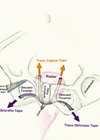Botulinum toxin is the first biological toxin to be licensed for use in treating human disease and since its first therapeutic use in the early 1980s for strabismus has become widely used in the fields of ophthalmology, cosmetic surgery, migraine and urology.
However, it remains one of the most dangerous and poisonous biological substances due its high potency and lethality – a single gram of the toxin can kill more than one million people [1]. So how did it evolve from toxin to therapeutic agent?
History
Botulism has been in existence likely from the beginning of human existence, however the connection between consumption of poorly stored food and death from a paralytic disease was not made until the 19th century. It is likely that many ancient texts describing deaths from paralysis from atropa belladonna are in fact describing cases of botulism and a 10th century edict of Emperor Leo VI of Byzantium banning the manufacture of “blood sausages” has its roots in the condition.
Following the Napoleonic wars there was a period of extreme poverty particularly in the Kingdom of Wurttemburg with a resulting impact on the sanitary measures used for rural food production. Multiple outbreaks of deaths from progressive muscle paralysis following the ingestion of sausages led to public health warnings and the beginnings of investigations into the underlying cause of “sausage poisoning”, then named botulism (deriving from the Latin word for sausage “botulus”). Initial thoughts of the poisoning being due to “prussic acid” were dismissed by the Medical Faculty of the University of Tubingen who suspected a “Zoonic, possible organic poison”, although the blame was attributed to housewives for not boiling the sausages long enough [2].

Figure 1.
German physician (and poet!) Justinus Kerner (Figure 1) was the first to publish a case series of 76 patients with an accurate description of botulism in 1820; describing in detail the symptoms and attributing the condition as directly related to the ingestion of sausages. He performed post-mortem examinations on victims as well as performing experiments on a variety of animals; administering “sour sausages” in order to examine the effect on the body. He deduced that the cause was a toxin that developed under anaerobic conditions and that it acted upon the motor and autonomic nervous system; he also theorised that the toxin could be used in small doses as a therapeutic agent in his 1822 monograph. However, further progress in identifying the toxin stalled until 1895.

Figure 2.
In 1895 there was a significant botulism outbreak of 34 people following a funeral dinner with smoked ham in the small Belgian village of Ellezeles resulting in three deaths. This outbreak was investigated by a professor of bacteriology Emile Pierre van Ermengen (Figure 2), University of Ghent, who carried out a detailed examination of both the ham and the organs of the deceased. He identified an anaerobic microorganism that he initially called Bacillus botulinus (later called Clostridium Botulinum) and was able to culture the organism and use it in animal experiments. His work was published in 1897, however the organism was felt to only be found in meat and fish products.
A botulism outbreak in 1904 due to canned white beans changed this opinion; when the organism involved was isolated and compared to that of the Ellezeles ham it was found to be a different strain and toxin; later subtyped by Georgina Burke in 1919 as A and B. Further outbreaks increased due to the increase in food canning and studies of the bacterium found that improperly preserved home canned foods, containing vegetables and animal products, allowed contamination with the bacteria and resultant spore formation. Techniques for killing the spores during canning and food preservation were developed and have been successful in significantly reducing outbreaks.
Development in medical use
Botulinum toxin was considered as a potential weapon during the World Wars and efforts by the US government into its potential use resulted in the ability to stabilise and manufacture botulinum toxin type A. Following the end of the war research continued on the toxin and thoughts turned towards its use as a therapeutic agent [1].
In 1973 Dr Alan Scott, an American ophthalmologist, used botulinum toxin A in monkey experiments to assess effectiveness as a treatment for strabismus. Successful trials on human volunteers in 1977 resulted in FDA approval in 1979 [3]. Since then, botulinum toxin has been approved for use in multiple conditions such as hyperhidrosis, cosmetic use for facial wrinkles and fine lines, limb spasticity, torticollis, chronic migraine and blepharospasm as well as urological indications discussed below.
What is botulinum neurotoxin?
Botulinum toxin (BoNT) is a neurotoxin which is produced by the anaerobic gram-positive bacteria Clostridium Botulinum, commonly found in plants, soil, lakes and the intestinal tracts of animals [2]. BoNT has seven sub-types with varying potencies – types A, B, E and F are known to cause botulism in humans whilst types C and D are found to only cause toxicity in animals. Sub-type A is primarily used in therapeutic applications and different preparations are available (BOTOX® – Allergan/AbbVie Pharmaceuticals, Dysport® – Ipsen Biopharm, and XEOMIN® – Merz Pharmaceuticals) [3].
Mechanism of action
BoNT acts on the neuromuscular junction by binding to receptors at the pre-synaptic surface of cholinergic neurones to create a toxin-receptor complex which is taken up by the cell by endocytosis. It cleaves synaptosomal-associated protein (SNAP-25) from the SNARE complex thereby preventing the release of acetylcholine at the neuromuscular junction via vesicle fusion. In the bladder this results in relaxation of the detrusor muscle as well as acting on sensory afferent pathways. Further evidence has shown BoNT acts on additional neurotransmitters such as substance P (a modulator for pain perception), ATP, cyclooxygenase-2 products and nitric oxide (all inflammatory response mediators) by reducing their release and therefore playing an important role in pain and inflammation [4].
The peak effect of BoNT is four to seven days after injection. It does not cause neuronal death and the effect is temporary as the toxin is degraded over time [5].
Administration
BoNT is administered as an intradetrusor injection via rigid or flexible cystoscopy. The vast majority of patients can safely undergo the procedure under local anaesthetic although a select cohort will undergo the procedure under regional or general anaesthetic, such as those at risk of autonomic dysreflexia. The toxin comes in a powder form in a vial which must be diluted with normal saline for injection – injection using sterile water causes pain. In our unit we generally dilute to a concentration of 10 units per 1ml of saline however there is no universally agreed evidence-based protocol regarding the location and number of injections and most practitioners will aim to inject evenly around the bladder. Trigonal sparing has been traditionally taught due to a theoretical risk of inducing vesico-ureteric reflux however several studies have not found this to be proven [6,7]. In most patients Botox can last between 6 to 12 months with an average duration time of 7.5 months [8].
Side-effects
BoNT treatment is minimally invasive and low risk in the majority of patients. Haematuria is common and almost expected for three days following the procedure, however it is rarely clinically significant requiring intervention. Uncomplicated urinary tract infections (UTI) requiring antibiotic treatment can occur in 15% of patients and recurrent UTIs can be seen in 2%. Urinary retention with the need to intermittently self-catheterise is the side-effect that most patients are concerned about; the rates vary between 6-20% depending on the dose and indication. It is important to ensure patients are both willing and able to perform intermittent self-catheterisation prior to performing the procedure or are willing to accept an indwelling catheter should they be unable to do so. Rare complications are seen in less than 0.4% of patients and include an allergic reaction or generalised muscle weakness [9].
Urological indications
In the UK BoNT A is licensed for treatment of idiopathic overactive bladder (OAB) and neurogenic detrusor overactivity (NDO).
Overactive bladder syndrome (OAB) is defined as urinary urgency with or without urgency urinary incontinence (UUI). Patients who have failed conservative management with lifestyle changes and pharmacological treatment can be offered the option of BoNT A or sacral neuromodulation [10]. There have been several randomised controlled studies which have shown significant improvement in OAB symptoms following BoNT A treatment. Nitti et al. reported a significant decrease in UUI rates in a randomised placebo-controlled study in 557 patients, with 22.9% of patients treated with 100 units of BoNT A completely continent versus 6.5% of placebo patients. The median time for patients to request re-treatment was 24 weeks [11]. This was supported by Chapple et al. who performed a randomised double-blind, placebo-controlled trial of 548 patients. A significant improvement was seen in all OAB symptoms and patient-reported benefit in patients treated with 100U of BoNT A versus placebo [12]. The recommended commencing dose for idiopathic OAB is 100U. National Institute for Health & Care Excellence (NICE) guidelines advise a 12-week follow-up following treatment and if the response has been inadequate the dose can be increased to 200U [10].
"In the UK BoNT A is licensed for treatment of idiopathic overactive bladder and neurogenic detrusor overactivity"
The effectiveness of BoNT A in neurogenic detrusor overactivity has been well established since first being described in a number of small studies from 2000 onwards. Cruz et al. reported the outcome of the first large multicentre, randomised, double-blinded, placebo-controlled trial in 2011. Two hundred and seventy-five patients with either multiple sclerosis or spinal cord injury were randomised to placebo, 200U BoNT or 300U BoNT treatment. Patients treated with 200U and 300U of BoNT had a significant reduction in urge urinary incontinence as well as an improvement in urodynamic parameters and quality of life [13]. Cheng et al. performed a systematic review and meta-analysis in 2016, including six randomised controlled trials of 1915 patients receiving 200U or 300U of BoNT for neurogenic DO. This confirmed a statistically significant reduction in UUI episodes and an improvement in urodynamics parameters. The initial commencement dose for patients with neurogenic DO is 200U, which can be increased to 300U if necessary [14-16].
There are a number of other described urological uses for BoNT; however, use in these conditions is off-licence. The initial described use for BoNT was in patients with detrusor sphincter dyssynergia (DSD) due to spinal cord injury in 1988 [17]. BoNT was injected into the urethral sphincter in order to induce the urethral pressure and therefore improve the efficiency of voiding. Results from studies showed decrease in the urethral pressure and post-void residual volume as well as the number of autonomic dysreflexia episodes and a 50% reduction in the number of urinary tract infections. However, there was also an increased risk of urinary incontinence and therefore this is not a routine treatment for patients with DSD [17].
BoNT has also been suggested as a potential treatment in female patients with voiding dysfunction. Nadeem et al. reported a retrospective review of 35 patients with a non-neurogenic non-relaxing sphincter causing voiding dysfunction and described an improvement in the post-void residual and quality of life parameters. They also reported that 21 of 28 patients who were catheter dependant prior to treatment were able to void. The duration of response was 4.7 months however two patients reported transient stress incontinence [18].
There has been interest in the use of BoNT in patients with bladder pain syndrome / interstitial cystitis (BPS/IC); in part due to the dual action of BoNT on the detrusor muscle and the sensory afferent pathways. Initial small studies had reported conflicting results, however a large randomised double-blind placebo controlled trial of 60 patients by Kuo et al. reported a significant reduction in pain scores with no difference in the adverse events [19]. The American Urological Association (AUA) recommend the use of BoNT as a fourth-line treatment for patients who have failed conventional options [19].
Conclusion
Since its first description in ancient texts, clostridium botulinum and its toxins have undergone a transformation from causing a poisonous life-threatening paralysis to being utilised in a wide range of medical conditions. The impact of BoNT treatment on improving the quality of life of patients with urological conditions should not be underestimated. Whilst the name of Justinus Kerner is not a household name, it is remarkable that many of the therapeutic uses of botulinum toxin were first postulated in his manuscript in 1822 and it is likely that further indications will be described in the future.
References
1. Dhaked RK, Singh MK, Singh P, Gupta P. Botulinum toxin: bioweapon & magic drug. Indian J Med Res 2010;132(5):489-503.
2. Erbguth FJ. Historical notes on botulism, Clostridium botulinum, botulinum toxin, and the idea of the therapeutic use of the toxin. Mov Disord 2004;19 Suppl 8:S2-6.
3. Kedlaya D. Botulinum toxin, overview, history, mechanism of action. Medscape 2022
https://emedicine.medscape.com/
article/325451-overview
4. Pirazzini M, Rossetto O, Eleopra R, Montecucco C. Botulinum neurotoxins: biology, pharmacology, and toxicology. Pharmacol Rev 2017;69(2):200-35.
5. Nigam PK, Nigam A. Botulinum toxin. Indian J Dermatol 2010;55(1):8-14.
6. Manecksha RP, Cullen IM, Ahmad S, et al. Prospective randomised controlled trial comparing trigone-sparing versus trigone-including intradetrusor injection of abobotulinumtoxinA for refractory idiopathic detrusor overactivity. Eur Urol 2012;61(5):928-35.
7. El-Hefnawy AS, Elbaset MA, Taha DE, et al. Trigonal-sparing versus trigonal-involved Botox injection for treatment of idiopathic overactive bladder: A randomized clinical trial. Low Urin Tract Symptoms 2021;13(1):22-30.
8. European Association of Urology. EAU guidelines on non-neurogenic female LUTS – disease management. 2022
https://uroweb.org/guidelines/non-neurogenic
-female-luts/chapter/disease-management
9. British Association of Urological Surgeons. Botulinum toxin injections into the bladder wall. 2020.
https://www.baus.org.uk/_userfiles/
pages/files/Patients/Leaflets/
Flexible%20cystoscopy.pdf
10. NICE. Guideline [NG123] Urinary incontinence and pelvic organ prolapse in women: management. 2019
https://www.nice.org.uk/guidance/
ng123/chapter/Recommendations#non
-surgical-management-of-urinary-incontinence
11. Nitti VW, Dmochowski R, Herschorn S, et al.; EMBARK Study Group. OnabotulinumtoxinA for the treatment of patients with overactive bladder and urinary incontinence: results of a phase 3, randomized, placebo controlled trial. J Urol 2013;189(6):2186-93.
12. Chapple C, Sievert K, MacDiarmid S, et al. OnabotulinumtoxinA 100U significantly improves all idiopathic overactive bladder symptoms and quality of life in patients with overactive bladder ad urinary incontinence: a randomised, double-blind, placebo-controlled trial. Eur Urol 2013;64:249-56.
13. Cruz F, Herschorn S, Aliotta P, et al. Efficacy and safety of OnabotulinumtoxinA in patients with urinary incontinence due to neurogenic detrusor overactivity: a randomised, double-blind, placebo-controlled trial. Eur Urol 2011;60(4):742-50.
14. Yuan H, Cui Y, Wu J, et al. Efficacy and adverse events associated with use of OnabotulinumtoxinA for treatment of neurogenic detrusor overactivity: a meta-analysis. Int Neurourol J 2017;21(1):53-61.
15. Cheng T, Shuang WB, Jia DD, et al. Efficacy and safety of OnabotulinumtoxinA in patients with neurogenic detrusor overactivity: a systematic review and meta-analysis of randomized controlled trials. PLoS One 2016;11(7):e0159307.
16. Wu SJ, Xu YQ, Gao ZY, et al. Clinical outcomes of botulinum toxin A management for neurogenic detrusor overactivity: meta-analysis. Ren Fail 2019;41(1):937-45.
17. Dykstra DD, Sidi AA, Scott AB, et al. Effects of botulinum A toxin on detrusor-sphincter dyssynergia in spinal cord injury patients. J Urol 1988;139:919-22.
18. Nadeem M, Lindsay J, Pakzad M, et al. Botulinum toxin A injection to the external urethral sphincter for voiding dysfunction in females: A tertiary centre experience. Neurourol Urodyn 2022;8:1793‑9.
19. Kuo HC, Jiang YH, Tsai YC, et al. Intravesical botulinum toxin-A injections reduce bladder pain of interstitial cystitis/bladder pain syndrome refractory to conventional treatment - A prospective, multicenter, randomized, double-blind, placebo-controlled clinical trial. Neurourol Urodyn 2016;35:609-14.
[All links last accessed February 2022]
Declaration of competing interests: None declared.









